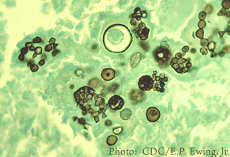National Institutes of Health
- The primary NIH organization for research on Valley Fever is the National Institute of Allergy and Infectious Diseases
 A service of the U.S. National Library of Medicine
A service of the U.S. National Library of Medicine  National Institutes of Health
National Institutes of Health
Valley Fever is a disease caused by a fungus (or mold) called Coccidioides. The fungi live in the soil of dry areas like the southwestern U.S. Anyone exposed to the fungus can get the infection. The highest risk is for people whose jobs expose them to soil dust. These include construction workers, agricultural workers, and military forces doing field training. The infection cannot spread from person to person.
Valley Fever is often mild, with no symptoms. If you have symptoms, they may include a flu-like illness, with fever, cough, headache, rash and muscle aches. Most people get better within several weeks or months. A small number of people may develop a chronic lung or widespread infection.
Valley Fever is diagnosed by testing your blood, other body fluids, or tissues. Many people with the acute infection get better without treatment. In some cases, doctors may prescribe antifungal drugs for acute infections. Severe infections require antifungal drugs.
Centers for Disease Control and Prevention
References and abstracts from MEDLINE/PubMed (National Library of Medicine)
